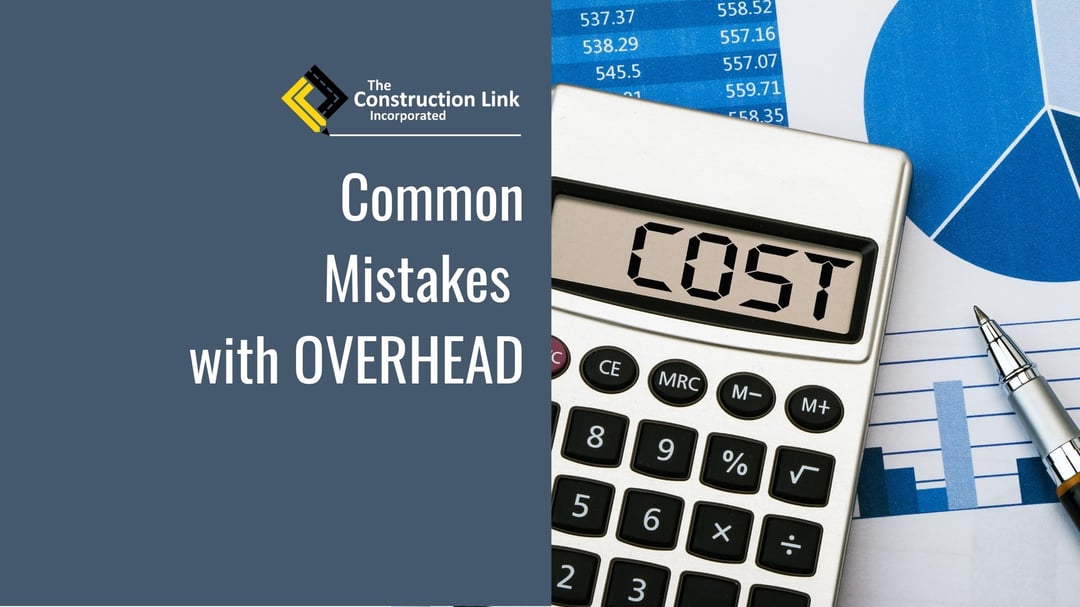
Common Mistakes with Overhead Costs in Your Construction Estimate
Overhead costs are one of the three categories of indirect costs. Overhead costs may include traveling, indirect labor, supplies, rent, and other expenses associated with construction. Indirect costs are the biggest category of construction expenses, but they can increase the potential for errors in estimates if not properly accounted for. Let’s talk about some common mistakes when estimating overhead costs.
Conflicting Data
Reoccurring costs often create a common mistake when they are put into different cost pools. For instance, the first estimate may categorize a cost as overhead, but the next![]() estimate categorizes the same cost as a G&A expense. This causes conflicting data when you are looking at your overall construction overhead costs. Certain costs belong to their respective groups and should not be represented in more than one category. Using an estimating software with a common database of costs greatly reduces the risk of erroneously reporting overhead costs.
estimate categorizes the same cost as a G&A expense. This causes conflicting data when you are looking at your overall construction overhead costs. Certain costs belong to their respective groups and should not be represented in more than one category. Using an estimating software with a common database of costs greatly reduces the risk of erroneously reporting overhead costs.
Mismanagement of Various Overhead Cost Pools
Most construction companies have more than one overhead cost pool. While this helps increase the visibility on a project, it creates the potential for errors. It is important to categorize overhead costs properly. This estimate data helps management make decisions about the project. If these numbers are not an accurate representation of the specific overhead cost pool, it may cause unexpected issues during the project.
Not Regularly Reviewing Construction Overhead Costs
Overhead costs and other indirect expenses fluctuate monthly. It is important to monitor them regularly to ensure there are no errors in the estimate. However, monitoring the changes may be difficult compared to tracking direct contract costs. Direct contract costs are reviewed by one or two managers, yet indirect expenses are monitored by multiple people. Communication is vital to ensuring the indirect costs represent the construction project. Not reviewing the indirect costs regularly could negatively impact your profits. Estimating software can help as it provides on-demand reporting on your projects.
Proposal Costs do not Match the Actual Expense
It is common for proposal costs to differ from actual costs because of price changes and rising demand. This may cause issues when you are trying to allocate costs across different overhead expenses. When you are reporting overhead costs in the estimate, all expenses should be accounted for when there are price changes. Estimating and Field Tracking software can help ease the pain of tracking these sometimes complex costs.
Not Labeling Your Cost Pools
If your estimate does not define the specific cost pools, it will be difficult to calculate the expenses of each group and the overall project. Cost pools should be divided into three pools: fringe, overhead, and G&A. This makes estimating and reviewing the cost pools easier when each category is defined correctly. Estimating Software makes it easy to define those costs pools and keep track of them.
Not Understanding Which Expenses are Overhead Costs
![]() Overhead costs are expenses that support the construction contract. Any expenses in this category should be necessary to complete the project. A frequent mistake some construction companies make is not assigning the correct cost to the right category. This ends up with an overhead cost being represented as a G&A and fringe expense. Then, the overhead rate is underrated, and the G&A costs are inflated. Training and establishing allocation policies help decrease errors when categorizing specific expenses in their cost pools. Using estimating software helps you easily establish those allocations for everyone in your estimating and accounting departments.
Overhead costs are expenses that support the construction contract. Any expenses in this category should be necessary to complete the project. A frequent mistake some construction companies make is not assigning the correct cost to the right category. This ends up with an overhead cost being represented as a G&A and fringe expense. Then, the overhead rate is underrated, and the G&A costs are inflated. Training and establishing allocation policies help decrease errors when categorizing specific expenses in their cost pools. Using estimating software helps you easily establish those allocations for everyone in your estimating and accounting departments.
Conclusion
Proper communication, periodic attention to cost fluctuations and allocations, along with using powerful construction software will go a long way toward avoiding mistakes when reporting overhead costs.
Interested in learning more about the most common construction estimating mistakes? Check out our blog post where we talk about everything from not using the right planning algorithms to underestimating labor costs.




